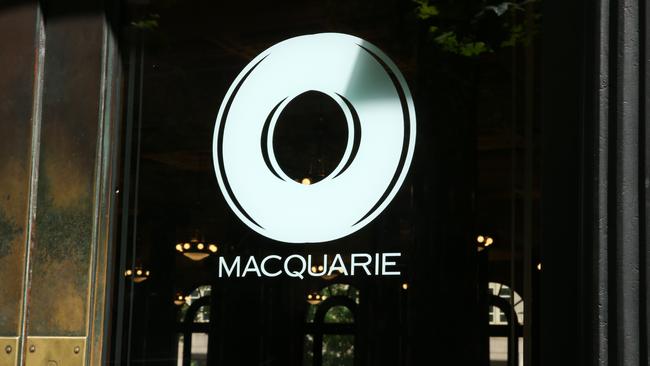After the AirTrunk high, what comes next for Macquarie?
An earnings miss; a watered-down outlook; and an effective dividend cut. It was a rare trifecta of negatives for the bank. Who’s game to bet against it?

Business
Don't miss out on the headlines from Business. Followed categories will be added to My News.
An earnings miss; a watered-down outlook; and an effective dividend cut. It was a rare trifecta of negatives for Shemara Wikramanayake’s Macquarie Group as the bank finds it increasingly tough to keep up with lofty expectations.
Some of that blue sky is of its own doing. Previous outperformance and windfalls have helped to drive a record share price. But what is clear from a string of profit results since the Covid pandemic, Wikramanayake’s bank has become a more volatile proposition. And this is the very thing Macquarie has spent much of the past decade trying to get away from.
Macquarie’s latest interim numbers were boosted by the performance fee generated after the bumper $21bn Airtrunk sale to Blackstone during the September half. Indeed it was the very act of the sale that boosted the valuation of several other similar assets sitting in one of Macquarie’s tech infrastructure funds that triggered the performance fee. This is the Macquarie model in action.
While the quantum of AirTrunk return has not been disclosed, overall it helped a 68 per cent jump in profit contribution from Macquarie’s flagship asset management business that is also home to the bank’s infrastructure and green energy assets.
At the same time, commodities trading, which delivered a stellar windfall as energy markets went haywire on Russia’s invasion of Ukraine, has now pulled right back. Earnings from commodities and markets, the other powerhouse unit, were down 5 per cent on the half. It was even softer on the March half, down 28 per cent.
Macquarie’s first half headline profit was up 14 per cent on the same time last year, although the pace of revenue growth slowed to 4 per cent. That and a more subdued outlook saw Macquarie’s shares drop as much as 4 per cent.

With the shine rapidly coming off green energy markets and the AirTrunk deal now locked away, what’s next for Macquarie?
There’s now two areas to watch.
The first and biggest is digital infrastructure. This is everything that’s helping to power the AI boom ranging from data centres and fibre cables to telco towers – as well as the energy needed to power it.
Macquarie has nearly a dozen data centre businesses sitting in its funds and these are each in different stages of growth.
The bank’s stellar AirTrunk sale early in September set a new high water mark and these assets will be sold in coming years. The bank will also get a surge of funds coming its way for the management of digital and related assets.
“At the moment, digital assets are a big area of investment, but so is the energy required for those assets, particularly in renewable energy and things like water cooling, are all being driven by this digitisation trend around the world,” Wikramanayake says. “We feel good about the outlook into the medium term.”
The other area is private credit where Macquarie is becoming a key player. This involves the direct lending to big business and infrastructure funds, at this stage it is high margin and low risk, Macquarie allocated $5bn in the September to private credit half versus $1.5bn in first half of last year. However this growth now puts the investment bank up against some of the world’s biggest asset managers, including Blackrock, KKR and Blackstone, as well as Australia’s own big super funds.
The issue for Macquarie is the earnings from the business will continue to be lumpy going into rest of the financial year for the investment bank, as well as the foreseeable future. A string of assets like green energy including offshore solar and wind as well as aircraft leasing have been sitting on the balance sheet for some time. These are set to be sold into funds and some into third parties.
Wikramanayake maintains her bank is still a much less volatile business from where its peers are. It’s less reliant on markets business, she says, rather it follows its customers and for commodities that usually means energy.
Macquarie is still looking at a high hurdle for the coming six months if it is to hit what investors have been pencilling in as a pre-tax earnings target of just over $4bn for the year.
A lot needs to go right including more performance fees as well as the sale of two big wind and solar assets. If it can get these deals away, it will be a remarkable turnaround from an underwhelming first half. But who’s going to bet against Macquarie?
johnstone@theaustralian.com.au
More Coverage
Originally published as After the AirTrunk high, what comes next for Macquarie?




